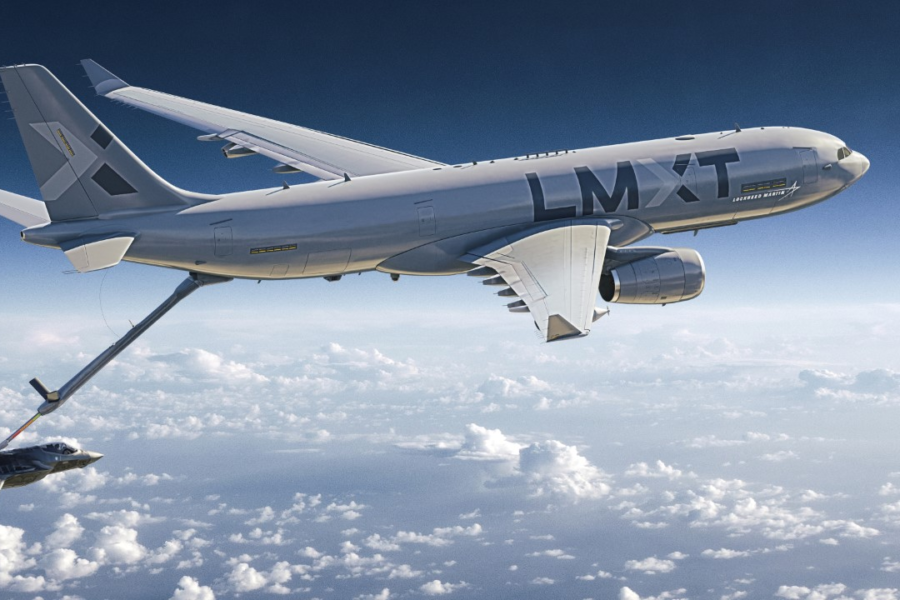Lockheed Martin has withdrawn its LMXT aerial refueler from the Air Force’s KC-135 fleet recapitalization program—previously referred to as the “bridge tanker” effort—the company said Oct. 23. However, its partner Airbus said it will press on, offering its Multi-Role Tanker Transport (MRTT) version of the aircraft.
A Lockheed spokesperson said the company will focus on the Next-Generation Air Refueling System (NGAS) program instead.
“Lockheed Martin has decided not to respond to the U.S. Air Force’s KC-135 fleet recapitalization Request for Information (RFI),” a company spokesperson said.
“We are transitioning Lockheed Martin’s LMXT team and resources to new opportunities and priority programs, including development of aerial refueling solutions in support of” the NGAS program, the spokesperson added. “We remain committed to the accelerated delivery of advanced capabilities that strengthen the U.S. Air Force’s aerial refueling missions.”
An Airbus spokesperson said the company “remains committed to providing the U.S. Air Force and our warfighters with the most modern and capable tanker on the market, and will formally respond” to the KC-135 recapitalization request for information. “The A330 U.S.-MRTT is a reliable choice for the U.S. Air Force: one that will deliver affordability, proven performance and unmatched capabilities,” they added.
The Air Force released the RFI on Sept. 14, but the document is “controlled” and not available for public dissemination. Lockheed had almost six weeks to review the document before deciding not to pursue the program further but would only say through the spokesperson that “a combination of a few factors in the RFI shaped our decision, as well as acceleration of the NGAS program.”
The company said the details of its partnership with Airbus are proprietary and would not say whether Lockheed faces any financial obligations to Airbus as a result of its decision to end its part of the LMXT.
As to whether any elements of the LMXT which Lockheed brought to the partnership could find their way into Airbus’ proposal, the Lockheed spokesperson said “any future tanking opportunities between Lockheed Martin and Airbus will need to be considered based on specific requirements and timelines.”
The Air Force was not immediately prepared to provide comment on Lockheed’s decision. Service officials said as recently as August that there is not as yet an acquisition strategy for the KC-135 recap program or NGAS, as the Air Force analysis of alternatives for both programs was to begin after the RFI responses.
The KC-135 recapitalization is currently projected to be a program of about 75 aircraft—at roughly 15 per year—meeting the Air Force’s desire to keep some kind of traditional refueling aircraft in production between the end of Boeing’s KC-46 program—which wraps up with 179 aircraft circa 2028—and operational service of the yet-undefined NGAS, in the mid-2030s.
The NGAS is expected to be a smaller tanker able to operate alongside combat aircraft in contested airspace; Air Force Secretary Frank Kendall has said the traditional approach of converting tube-and-wing-type freight aircraft into tankers will no longer be survivable in the late 2030s.
The service wants to preserve competition as much as possible, but Kendall has said that the cost of a competition—and a separate logistics train for a different aircraft—may not be worth it. Some members of Congress—particularly the Alabama delegation, where Lockheed would have assembled the LMXT—have objected to the idea of Boeing receiving a sole-source contract for more or modified versions of the KC-46.
Lockheed and Airbus’s LMXT proposal was based on the Airbus A330 Multi-Role Tanker Transport (MRTT), but with additional capabilities and features that would be unique to USAF. In June, Lockheed pitched the LMXT as a “mothership” for the NGAS fleet of smaller, stealthier tankers.
A European Aeronautic Defense and Space (EADS)-Northrop Grumman offering of an Airbus A330-based tanker was Boeing’s competition in several USAF tanker contests since the early 2000s, and was selected as the winner in 2008, receiving the designation KC-45. But that award was thrown out after a protest by Boeing, which won the re-compete with what is now called the KC-46. In that recompete, Northop left the KC-45 partnership—saying the rewritten contest rules favored Boeing’s entry—and Airbus entered on its own.
Lockheed’s campaign lead for the LMXT, Larry Gallogly, said in a June phone call with defense reporters that while 75 airplanes would have been a challenging business case for the aircraft, Lockheed expected the Air Force would need more time—and more tankers—because the Air Force’s NGAs timeline is a “very aggressive target.” He said 150 bridge tankers was more probable, and other company officials have said that a minimum of 110 aircraft was needed to close the business case.
Lockheed touted the LMXT as a hedge against a “single point failure” of the Air Force’s air refueling enterprise if Boeing’s KC-46 fleet was grounded. However, the LMXT, which is significantly larger than the KC-46, would be limited to a smaller number of airfields than the Boeing jet—a potentially problematic issue given the Air Force’s “Agile Combat Employment” model for operating from a widely dispersed number of airfields. Lockheed said the jet’s extra fuel capacity would enable it to operate from well outside contested airspace. The aircraft would also have had automatic air refueling capability; a feature the Air Force is eyeing for latter versions of the KC-46.
